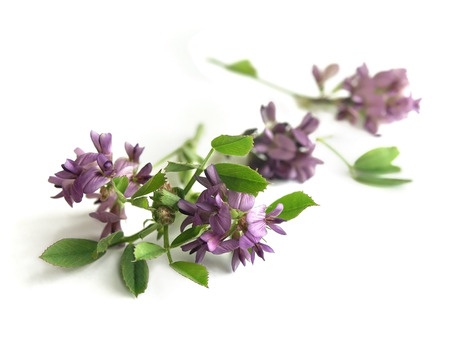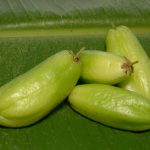
Alfalfa or Lucerne as it’s known in Europe is a crop similar to clover but with a number of surprising health benefits. We love it for both texture and taste when added to salads and other foods. Generally speaking it is associated with:-
- lowering cholesterol levels,
- improving digestion,
- protecting heart health,
- reducing the impact of some cancers,
- helping to reduce respiratory conditions,
- detoxifying the body,
- helping with immunity,
- reducing the impact of inflammation.
What is Alfalfa?
Alfalfa is an important foraging crop globally. It is known as alfalfa in North America and as Lucerne in Europe and Asian countries. It was first cultivated in south-central Asia but it has now become a globally recognized crop due to its impressive nutritional content and versatility in use. The sprouts are perhaps the most popular forms to eat and are used in sandwiches and salads.
It is primarily used for feedstock for animals and livestock, particularly as part of a sweet hay and makes for effective silage during winter months. Scientifically known as Medicago sativa, (L.) and belonging to the Fabaceae family, this plant remains an important staple crop for humans as well, primarily for the alfalfa sprouts.
The fibre content and nutritional profile that benefits animals is slightly different than the part of the plant humans tend to eat, but the value is clear. It contains the following vitamins:-
- vitamin A
- vitamin B (various)
- vitamin C
- vitamin D (not a bad vegetarian source by the way)
- vitamin E
- vitamin K
There are a number of proteins, antioxidants and minerals to be found in the sprouts which are probably the most readily and easily form of this food. The key minerals are magnesium, calcium and iron. The sprouts are also full of phytoestrogens which are associated with alleviating the symptoms of menopause and combating estrogen deficiency.
There are a number of surprising compounds isolated from various fractions of the plant. These include:- β-sitosterol and stigmasterol from the petroleum ether fraction; 10-hydroxy-coumestrol, apigenin, genistein, p-hydroxybenzoic acid, 7, 4′- dihydroxyflavone, quercetin-3-glucoside and sissotrin from the ethyl acetate fraction (Seida et al., 2015).
Risks With Alfalfa
Alfalfa must be eaten in moderation and as with feeding of farm livestock, care must be taken to monitor their health if the diet is primarily from this type of fodder. The crop has a high nitrogenous content which is attributed to its rich array of amino acids.
There are a few issues associated with consuming alfalfa. The raw plant is claimed to cause inflammation as opposed to reducing it and has been shown to produce a type of lupus in both animals and humans. One particular amino acid which is rarely found in other plants is L-canavanine and is attributed to causing this unpleasant condition.
If alfalfa is allowed to become too wet, there is damaging build up of coumarins such as coumestrol (Knuckles et al., 1976).
Do not take alfalfa supplements during pregnancy.
Whilst there is an estrogen hormone like benefit, caution must be exercised as excess alfalfa consumption can negatively alter hormone levels.
Health Benefits of Alfalfa
The health benefits of Alfalfa include its ability to lower cholesterol levels, reduce inflammation and treat gastrointestinal issues. One of the most traditional treatments using alfalfa is in diabetes management.
Alfalfa is probably best taken as a supplement when a certain health benefit is required. It comes in both capsule, powder, tablet and liquid extracts and sometimes in combination with other vitamins such as vitamin K.
The whole plant
For many, different parts of the plant have been used in a herbal medicine capacity. in traditional Chinese medicine, fresh alfalfa juice is a treatment for kidney stones. The plant’s root is used to treat fevers and alleviate jaundice whilst the leaves contain a saponin which may lower blood cholesterol. Clearly, choice of the right part of the plant is key here.
Reduction of Blood Cholesterol Levels
One well researched area for alfalfa comes in the cardiovascular health field. The presence of stigmasterol in the plant extracts has long been associated with reduction in cholesterol levels and in many of the diabetic management studies in rats, a corresponding reduction has been seen in blood cholesterol level.
Management Of Diabetes
The developing interest in managing diabetes comes from studies in rates who have had diabetes induced. These have been fed the aerial parts of the plant (Gray and Flatt, 1997; Khaleel et al., 2005; Baxi et al., 2010) where positive benefits have been demonstrated.
There has been a human clinical trial in Budapest, Hungary where the effects of an alfalfa leaf extract were tried on 20 diabetic patients. The alfalfa extract was dosed at 1g, twice per day for over 16 weeks. Patients showed a 24 per cent drop in blood cholesterol after eight weeks and which stabilised in the following months. The area of research requires larger sample sizes to make any claims.
It is thought that the flavone and isoflavone derivatives isolated in the various solvent fractions are solely responsible for the hypoglycaemic effect. This is the effect where blood sugar levels are reduced and spiking is prevented which is in part associated with resistance to insulin as in type-2 diabetes. These same compound types are found in other plants such as Clausenalansium stem bark extracts, (Ammar and El-Okbi, 1988; Adebajo et al., 2009).
Alfalfa Fiber
All fiber, whether it is soluble or insoluble offers a variety of benefits. One is absorbing harmful free radicals literally by a physical action, the others are improving bowel movements and stomach and gut motion.
Growing Alfalfa As Sprouts
Once you start growing, be patient as it takes about 1 week for your harvest of sprouts to be growing to a size suitable for harvesting.
- Pick a medium-sized jar of at least 9cm in diameter and 15cm in height.
- Place 1-2 tablespoons of alfalfa seeds in the jar, sock in tap water for 3 hours.
- Place a gauze sheet over the jar and fix with a rubber band or string.
- Drain off the water.
- Store the jar away from direct sunlight and place at an angle to drain excess water.
- Rinse the sprouts 2 or 3 times everyday.
- Gently shake the jar every now and then to prevent the sprouts from intergrowing and tangling up.
References
Adebajo, A.C., Iwalewa, E.O., Obuotor, E.M., Ibikunle, G.F., Omisore, N.O., Adewunmi, C.O., Obaparusi, O.O., Klaesf, M., Adetogun, G.E., Schmidt, T.J. and Verspohl, E.J. (2009). Pharmacological properties of the extract and some isolated compounds of Clausenalansium stem bark: Anti-trichomonal, antidiabetic, anti-inflammatory, hepatoprotective and antioxidant effects. J. Ethnopharmacol., 122: pp. 10-19
Ammar, N.M. and El-Okbi, S. (1988). Effect of four flavonoids on blood glucose of rats. Arch. Pharm. Res., 11(2) pp. 166-168
Batta, A. K., Xu, G., Honda, A., Miyazaki, T. and Salen, G. (2006). Stigmasterol reduces plasma cholesterol levels and inhibits hepatic synthesis and intestinal absorption in the rat. J. Metabolism., 55(3): pp. 292-299.
Baxi, D.B., Singh, P.K., Doshi, A.A., Arya, S., Mukherjee, R. and Ramachadran, A.V. (2010). Medicago sativa leaf extract supplementation corrects diabetes induced dyslipidemia, oxidative stress and hepatic renal functions and exerts antihyperglycemic action as effective as metformin. Ann. Bio. Res., 1(3): pp. 107-119.
Gray, A.M. and Flatt, P.R. (1997). Pancreatic and extrapancreatic effects of traditional anti-diabetic plant, Medicago sativa (lucerne). Br. J. Nutr., 78: pp. 325-334
Khaleel EA, Gad ZM, El-Maraghy AS, Hifnawy SM and Abdel-Sattar E (2005). Study of hypocholesterolemic and antiatherosclerotic properties of Medicago sativa L. cultivated in Egypt. J. Food and Drug Anal., 13(3): pp. 212-218.
Knuckles, B.E., Defermery, D. and Koehler, G.O. (1976). Coumestrol content of fractions obtained during wet processing of alfalfa. J. Agric. Food. Chem., 24: pp. 1177-1180.
Seida, A., El-Hefnawy, H., Abou-Hussein, D., Mokhtar, F.A., Abdel-Naim, A. (2015) Evaluation of Medicago sativa L. sprouts as antihyperlipidemic and antihyperglycemic agent. Pak. J. Pharm. Sci., 28 (6) pp.2061-2074

Interesting article and makes you realise how important this whole subject is.